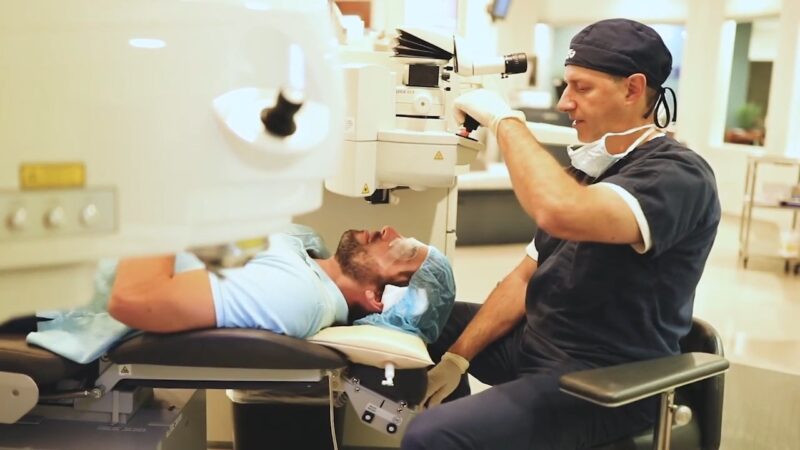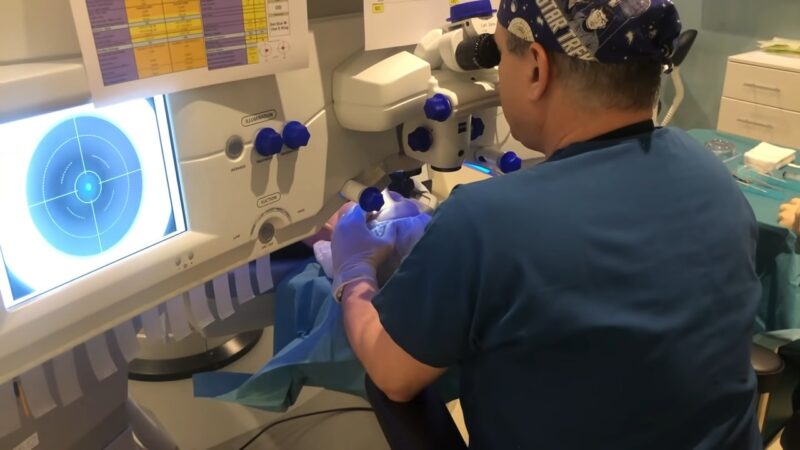Astigmatism is a common eye condition that affects millions of people worldwide. This refractive error occurs when the shape of your eye’s cornea or lens is irregular, causing blurry or distorted vision. If you’re one of the many people who have astigmatism, you might be wondering if laser eye surgery can help you see more clearly.
In this comprehensive guide, we’ll explore the different types of laser eye surgery, how they can correct astigmatism, and the factors you should consider before opting for this life-changing procedure. We’ll also discuss the risks, benefits, and what to expect during the recovery process. So, let’s dive into the world of laser eye surgery and find out if it’s the right solution for your astigmatism.
Astigmatism Explained
To understand how laser eye surgery can help correct astigmatism, it’s essential to know what causes this condition in the first place. Astigmatism occurs when the cornea or lens of your eye has an irregular shape, preventing light from focusing correctly on the retina. This irregularity results in blurry or distorted vision, which can vary in severity depending on the degree of astigmatism.
There are two main types of astigmatism:
- Corneal Astigmatism: This is the most common type and occurs when the cornea, the clear front surface of the eye, has an irregular shape.
- Lenticular Astigmatism: This type occurs when the lens of the eye is irregularly shaped.
Both types of astigmatism can be corrected with laser eye surgery, which we’ll discuss in more detail below.
Types of Laser Eye Surgery for Astigmatism

Laser eye surgery has become an increasingly popular choice for correcting astigmatism and other refractive errors like nearsightedness and farsightedness. There are three primary laser eye surgery procedures used to treat astigmatism:
1. LASIK (Laser-Assisted in Situ Keratomileusis)
LASIK is the most popular laser eye surgery and involves creating a thin flap on the cornea’s surface, which is then lifted to reshape the underlying corneal tissue using an excimer laser. After the cornea is reshaped, the flap is repositioned, and the eye heals naturally.
2. PRK (Photorefractive Keratectomy)
PRK is a slightly older procedure compared to LASIK but still very effective. In PRK, the surgeon removes the thin outer layer of the cornea, called the epithelium, before using an excimer laser to reshape the cornea. The epithelium then regrows over the course of several days.
3. SMILE (Small Incision Lenticule Extraction)
SMILE is a newer, minimally invasive procedure that involves using a femtosecond laser to create a small lenticule (a thin disc of corneal tissue) within the cornea. The surgeon then removes the lenticule through a tiny incision, resulting in a reshaped cornea and improved vision.
All three types of laser eye surgery can effectively treat astigmatism by reshaping the cornea, allowing light to focus correctly on the retina.
Factors to Consider Before Laser Eye Surgery
While laser eye surgery can provide life-changing results for people with astigmatism, it’s essential to carefully consider several factors before deciding if it’s the right choice for you.
1. Candidacy
Not everyone with astigmatism is a suitable candidate for laser eye surgery. Factors such as corneal thickness, age, overall eye health, and the severity of your astigmatism can all affect your eligibility. Consult with a qualified eye surgeon to determine if you’re a good candidate for the procedure.
2. Cost
Laser eye surgery can be expensive, with prices varying depending on the type of procedure and the surgeon’s experience. While some insurance plans may partially cover the cost, many consider it an elective procedure and do not offer coverage. Carefully weigh the financial implications before moving forward with the surgery.
3. Risks and Side Effects
Although laser eye surgery is generally safe and effective, it does come with potential risks and side effects. These may include dry eyes, glare, halos, infection, or undercorrection/overcorrection. Discuss these risks with your eye surgeon to fully understand what to expect.
4. Recovery Time
The recovery period can vary depending on the type of surgery you undergo. While most people can return to their daily activities within a few days after LASIK or SMILE, PRK may require a longer recovery time due to the need for the epithelium to regrow. Ensure you can commit to the necessary recovery time before undergoing the procedure.
The Laser Eye Surgery Process for Astigmatism

If you’ve decided that laser eye surgery is the right option for your astigmatism, here’s what you can expect during the process:
Preoperative Evaluation
Your eye surgeon will conduct a thorough examination to determine your candidacy for laser eye surgery, measure the severity of your astigmatism, and create a customized treatment plan. This evaluation may include corneal mapping, measuring your corneal thickness, and assessing your overall eye health.
The Procedure
Depending on the type of laser eye surgery you’ve chosen, the procedure will generally take around 10 to 15 minutes per eye. During the surgery, your eye will be numbed using anesthetic eye drops, and a device will be used to keep your eye open. Your surgeon will then use the laser to reshape your cornea according to your specific needs.
Recovery
After the surgery, you’ll likely experience some temporary discomfort and blurred vision. Your surgeon will provide you with postoperative instructions to help ensure a smooth recovery, which may include using antibiotic and anti-inflammatory eye drops, wearing protective eyewear, and avoiding certain activities for a period of time.
The Results: What to Expect After Laser Eye Surgery

Many patients experience significant improvements in their vision following laser eye surgery, often achieving 20/20 vision or better. However, individual results can vary, and some patients may still require glasses or contact lenses for certain activities, such as reading or driving at night.
While laser eye surgery can be a life-changing solution for many people with astigmatism, it’s crucial to have realistic expectations and understand that the results may not be perfect. It’s also worth noting that your vision may change over time due to aging or other factors, potentially requiring additional treatment in the future.
Lens Implants for Astigmatism
If you’re not a suitable candidate for laser eye surgery or prefer an alternative method, lens implants can offer a viable solution for correcting astigmatism:
Toric Intraocular Lenses (IOLs)
Toric IOLs are specially designed lenses that correct astigmatism by compensating for the irregular corneal shape. These lenses are typically used in cataract surgery, where the natural lens is replaced with a synthetic lens. Toric IOLs can also be used in a procedure called refractive lens exchange (RLE) for patients without cataracts who want to correct their astigmatism and other refractive errors.
Phakic Intraocular Lenses (PIOLs)
Unlike IOLs, PIOLs are implanted without removing the eye’s natural lens. These lenses are placed either in front of or behind the iris, providing an additional focusing element to correct astigmatism. Two common types of PIOLs are the Visian ICL (Implantable Collamer Lens) and Verisyse phakic IOL.
Orthokeratology for Astigmatism
Orthokeratology, or Ortho-K, is a non-surgical treatment option that uses specially designed gas-permeable contact lenses to temporarily reshape the cornea. The lenses are worn overnight, gently molding the cornea while you sleep. Once removed in the morning, the reshaped cornea provides clearer vision throughout the day without the need for glasses or contact lenses.
While Ortho-K is an effective treatment for mild to moderate astigmatism, it does not provide a permanent solution. Regular use of the lenses is necessary to maintain improved vision. This option is particularly popular among those who cannot undergo laser eye surgery due to thin corneas or other contraindications.
Final Words
Laser eye surgery has proven to be a highly effective solution for correcting astigmatism and providing clearer, more precise vision. By understanding the different types of laser eye surgery, weighing the factors to consider, and learning what to expect throughout the process, you can make an informed decision about whether this life-changing procedure is right for you.
If you’re considering laser eye surgery to correct your astigmatism, consult with a qualified eye surgeon to discuss your options and determine the best course of action for your unique needs. With the right guidance and preparation, you may be well on your way to enjoying improved vision and a newfound sense of freedom.





